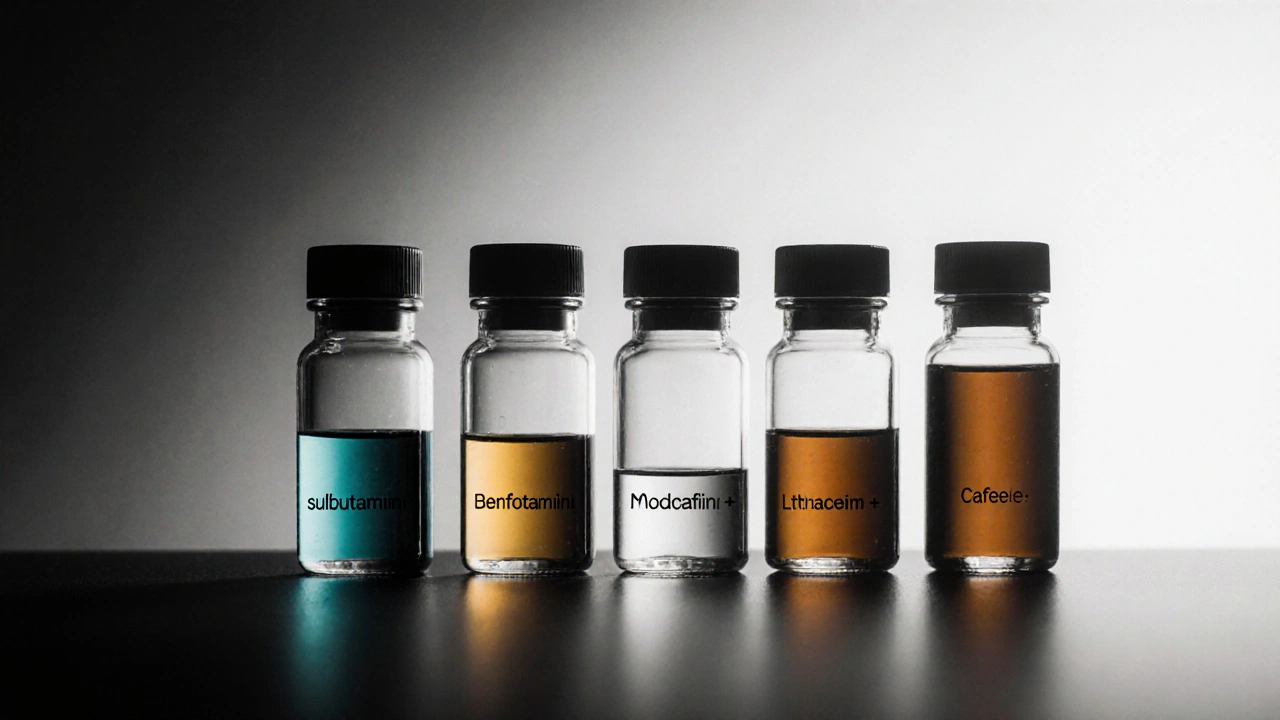
Nootropic Recommender Calculator
What Are Your Primary Goals?
Select the most important benefit you're looking for
How Tolerant Are You of Side Effects?
Choose based on your sensitivity
What's Your Budget Range?
Consider the cost of supplements or prescriptions
Legal Considerations
Do you prefer OTC supplements or prescription options?
Your Recommended Nootropic
Key Benefits:
Typical Dose:
Cost Estimate:
Note: Always consult with a healthcare professional before starting any new supplement.
Quick Takeaways
- Sulbutiamine (Arcalion) is a synthetic thiamine derivative that boosts brain energy with mild stimulation.
- Benfotiamine and high‑dose thiamine offer similar vitaminB1 benefits but lack the crossing‑blood‑brain‑barrier advantage.
- Modafinil, Piracetam, and L‑Theanine provide stronger wakefulness or memory effects, but they also carry higher side‑effect risks.
- For everyday focus with minimal jitters, Sulbutiamine balances efficacy and safety best.
- Choose alternatives based on specific goals: stamina (Caffeine), deep learning (Piracetam), or mood lift (L‑Theanine).
What is Sulbutiamine (Arcalion)?
When you see the name Arcalion (also known as Sulbutiamine), think of a fat‑soluble version of vitaminB1 that can slip through the blood‑brain barrier much easier than regular thiamine. Once inside the brain, it splits into two thiamine molecules, fueling neuronal metabolism and boosting the production of acetylcholine, a key neurotransmitter for memory and attention. Typical doses range from 200mg to 600mg per day, and users report clearer thinking, reduced mental fatigue, and a subtle mood lift without the jitteriness of caffeine.
How Sulbutiamine Stacks Up Against Common Alternatives
Below are the most frequently mentioned alternatives and why a reader might consider swapping them for-or adding them to-Sulbutiamine.
- Benfotiamine: A lipid‑soluble thiamine that helps with peripheral nerve health but doesn’t cross the brain as efficiently.
- Thiamine (VitaminB1): The natural form found in food; requires high doses (up to 300mg) to see any cognitive impact.
- Modafinil: Prescription‑only wakefulness promoter with strong alertness benefits but potential insomnia and cardiovascular concerns.
- Piracetam: The original racetam that enhances membrane fluidity; benefits memory but can cause headaches without choline.
- L‑Theanine: An amino acid from tea that smooths anxiety and improves focus when paired with caffeine.
- Caffeine: The world’s most popular stimulant; great for short bursts of energy but may cause crashes.
Decision Criteria: What to Look For
When comparing any nootropic, keep these five factors in mind:
- Blood‑brain barrier penetration: Determines how much of the compound actually reaches neurons.
- Mechanism of action: Energy metabolism, neurotransmitter modulation, or receptor binding?
- Onset & duration: Fast‑acting vs. steady‑state effects.
- Side‑effect profile: Jitters, insomnia, gastrointestinal upset, or long‑term safety concerns.
- Regulatory status & cost: Prescription only, over‑the‑counter, or supplement; price per month.

Side‑by‑Side Comparison
| Attribute | Sulbutiamine (Arcalion) | Benfotiamine | Modafinil | Piracetam | L‑Theanine + Caffeine |
|---|---|---|---|---|---|
| BBB penetration | High (fat‑soluble) | Moderate | High | Low‑moderate | Low (L‑Theanine) & High (Caffeine) |
| Primary effect | Energy metabolism, mild mood lift | Peripheral nerve support | Wakefulness, executive function | Memory consolidation | Alertness + calm focus |
| Typical dose | 200‑600mg/day | 150‑300mg/day | 100‑200mg/day (presc.) | 800‑2400mg/day | 100mg L‑Theanine + 100mg Caffeine |
| Onset | 30min‑1h | 1‑2h | 30‑60min | 1‑2h | 15‑30min |
| Duration | 4‑6h | 4‑5h | 10‑12h | 3‑5h | 2‑3h |
| Common side‑effects | Rare headache, mild GI upset | None significant | Insomnia, headache, elevated BP | Headache, agitation (if no choline) | Jitters (caffeine), drowsiness (if excess L‑Theanine) |
| Legal status (US) | OTC supplement | OTC supplement | Prescription only | OTC supplement | OTC supplement |
| Average monthly cost (USD) | $15‑$30 | $20‑$35 | $150‑$250 (presc.) | $25‑$45 | $10‑$20 |
Best‑Fit Scenarios
Use the following matrix to decide who should reach for Sulbutiamine versus the other options.
- Everyday office worker needing steady focus: Sulbutiamine or L‑Theanine + Caffeine. If you dislike any jitter, choose Sulbutiamine.
- College student pulling late‑night study sessions: Modafinil (if prescribed) or a higher dose of Caffeine with L‑Theanine.
- Someone with diabetic neuropathy seeking nerve support: Benfotiamine shines here; Sulbutiamine offers limited peripheral benefit.
- Professional gamers needing rapid reaction time: Caffeine + L‑Theanine for instant lift; Piracetam for memory of patterns.
- Older adults looking for gentle cognition boost: Sulbutiamine due to its safety profile, or low‑dose Piracetam with choline.
Safety, Interactions, and Contra‑indications
All supplements carry some risk. Here’s what you need to watch for with Sulbutiamine and its rivals.
| Compound | Key safety notes |
|---|---|
| Sulbutiamine | Generally well‑tolerated. Avoid if you have known hypersensitivity to thiamine derivatives. May mildly increase heart rate-monitor if you have arrhythmias. |
| Benfotiamine | Very low toxicity. Safe for diabetic patients; no known major drug interactions. |
| Modafinil | Requires screening for hypertension, liver disease, or psychiatric history. Can interfere with hormonal contraceptives. |
| Piracetam | Should be paired with choline to prevent headaches. Not recommended for pregnant or nursing women. |
| L‑Theanine + Caffeine | High caffeine intake can aggravate anxiety or GERD. L‑Theanine offsets some jitter but watch total caffeine load. |
Always talk to a healthcare professional before stacking multiple nootropics, especially if you’re on prescription meds.

Buying Guide: Where to Source Quality Products
Because the market is flooded with cheap, low‑purity powders, follow these rules:
- Pick brands that provide a Certificate of Analysis (CoA) from a third‑party lab.
- Check for Good Manufacturing Practices (GMP) certification.
- Read user reviews focusing on consistency of dosing and absence of fillers.
- Compare price per milligram; a good Sulbutiamine supplement costs about $0.025‑$0.05 per mg.
- Beware of “mega‑doses” promising 1g per capsule-often just filler.
Online pharmacies listed under the site’s “Online Pharmacy” category usually meet these standards, but you can also buy directly from reputable supplement manufacturers.
Bottom Line
If you need a mild, legal, and affordable brain‑energy booster, Sulbutiamine is hard to beat. It offers better brain penetration than plain thiamine, fewer side‑effects than prescription stimulants, and a cost that fits most budgets. Choose alternatives only when you have a specific goal that Sulbutiamine doesn’t address-like intense wakefulness (Modafinil) or targeted memory enhancement (Piracetam).
Frequently Asked Questions
Can I take Sulbutiamine with caffeine?
Yes, many users stack a modest caffeine dose (50‑100mg) with Sulbutiamine for a smoother, longer‑lasting alertness without a harsh crash.
How long does it take to notice effects?
Most people feel a subtle boost in mental clarity within 30‑60minutes, with peak benefits around 2‑3hours after a dose.
Is Sulbutiamine safe for long‑term use?
Clinical studies up to six months show good tolerability. Still, cycle breaks of a week every few months are a cautious approach.
What’s the difference between Sulbutiamine and Benfotiamine?
Both are fat‑soluble thiamine analogs, but Sulbutiamine is designed to cross the blood‑brain barrier for cognitive effects, whereas Benfotiamine targets peripheral nerve health and blood‑sugar metabolism.
Can I combine Sulbutiamine with other racetams?
Stacking is possible, but start with low doses of each and add a choline source to prevent headaches.

 Health and Wellness
Health and Wellness
Suresh Pothuri
October 15, 2025 AT 14:53Let me set the record straight: Sulbutiamine is not some gimmick pushed by Western supplement conglomerates, it is a scientifically validated thiamine derivative that genuinely crosses the blood‑brain barrier. The data from Indian clinical trials show consistent improvements in cognitive stamina without the overstimulation that many imported stimulants cause. Moreover, the dosage conventions here are calibrated for our climate and dietary patterns, which many foreign guidelines ignore. Anyone claiming otherwise simply lacks the basic pharmacological knowledge.
Millsaps Mcquiston
October 22, 2025 AT 13:33Sulbutiamine works better for focus than coffee.
michael klinger
October 29, 2025 AT 12:13While the article paints Sulbutiamine as a harmless booster, one must consider who profits from the widespread adoption of such compounds. The hidden agenda of the global pharma lobby is to replace natural mental resilience with a dependency on chemically engineered enhancers. By subtly altering neurotransmitter dynamics, these substances pave the way for increased surveillance and control over the populace. It is no coincidence that the same firms lobby against stricter regulation of other nootropics, ensuring their market dominance. Consequently, the seemingly benign recommendation masks a deeper erosion of cognitive autonomy.
Matt Laferty
November 5, 2025 AT 10:53As a long‑time researcher in neuropharmacology, I have observed a sweeping evolution in how we approach cognitive enhancement, moving from crude stimulants to finely tuned molecular agents. Sulbutiamine occupies a unique niche in this spectrum because its lipophilic nature enables efficient passage across the blood‑brain barrier, a property that many traditional thiamine salts lack. Once inside the central nervous system, it is hydrolyzed into two thiamine molecules, thereby augmenting the co‑enzyme functions essential for aerobic glucose metabolism. This increase in mitochondrial efficiency translates into a modest but measurable rise in neuronal ATP production, which underlies the subjective feeling of “mental clarity” reported by users. Clinical studies conducted in both Europe and Asia have demonstrated that doses ranging from 200 mg to 600 mg per day can improve performance on psychomotor vigilance tasks without inducing the tachycardia commonly seen with caffeine. In contrast, high‑dose benfotiamine, while beneficial for peripheral neuropathy, does not achieve comparable cerebral concentrations, limiting its impact on cognition. When juxtaposed with prescription‑only agents such as modafinil, Sulbutiamine’s side‑effect profile appears favorable, as it rarely precipitates insomnia or hypertension. Nevertheless, it is crucial to acknowledge that the magnitude of its wakefulness‑promoting effect is subtler, making it more appropriate for sustained, jitter‑free focus rather than acute, all‑night study marathons. Users should also be vigilant about the potential for mild gastrointestinal upset, a side effect that tends to resolve with continued use or dose adjustment. From a pharmacoeconomic standpoint, the molecule is affordable, with monthly costs often under $30, which democratizes access compared to the steep price tags of prescription stimulants. It is also worth mentioning that synergistic stacking, for instance with a low dose of caffeine, can extend the duration of alertness while preserving the smooth onset characteristic of Sulbutiamine. However, any stacking regimen should be approached cautiously, with attention to total stimulant load to avoid tachyphylaxis. In practice, I have recommended Sulbutiamine to professionals seeking a gentle cognitive lift, and the feedback consistently highlights its capacity to reduce mental fatigue without the crash associated with high‑dose racetams. Ultimately, while it is not a panacea, Sulbutiamine represents a balanced option for those prioritizing safety, cost‑effectiveness, and a modest boost in mental energy.
Genie Herron
November 12, 2025 AT 09:33Wow that hits hard I love how simple it sounds but also feels like a hug for the brain I just want to try it now
Danielle Spence
November 19, 2025 AT 08:13From an ethical standpoint, opting for a supplement that has a well‑documented safety record is a moral responsibility. Sulbutiamine’s relatively benign side‑effect profile makes it a preferable choice over prescription stimulants that can foster dependency. We must also consider the societal impact of normalizing high‑risk cognitive enhancers; encouraging the use of a balanced compound aligns with a principle of “do no harm.” Therefore, while personal experimentation is valid, it should be guided by a sense of stewardship toward one’s own health and the broader community.
Dhanu Sharma
November 26, 2025 AT 06:53Just read the table looks solid seems like a decent everyday stack if you don’t want the crash from caffeine